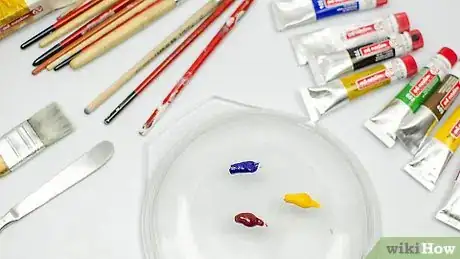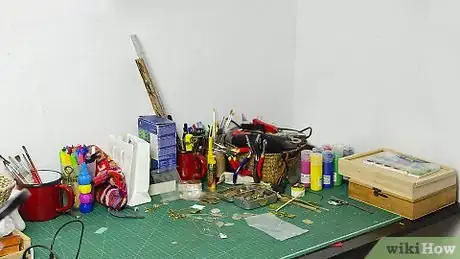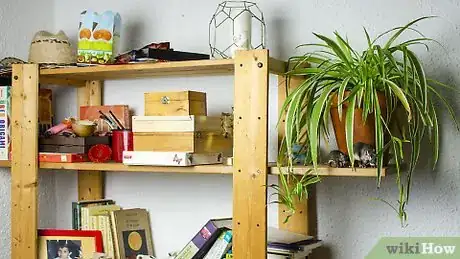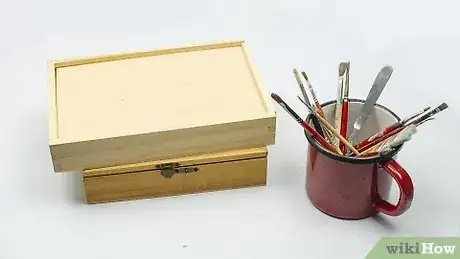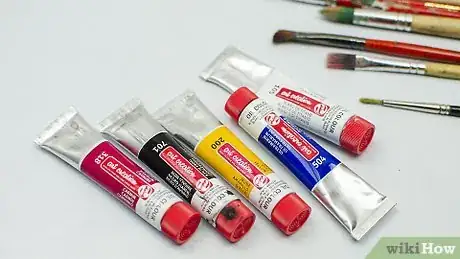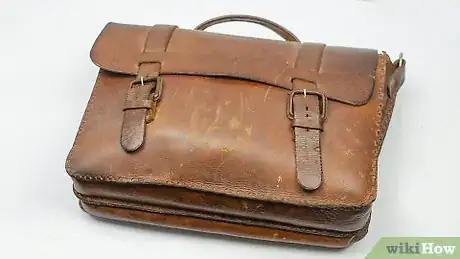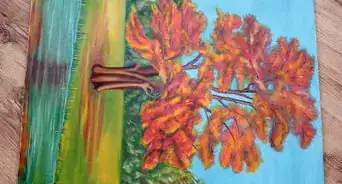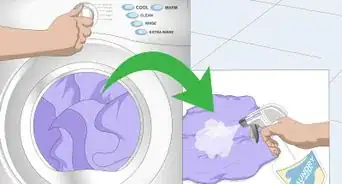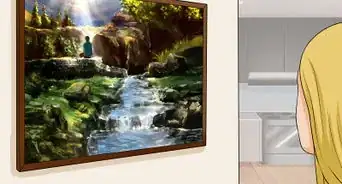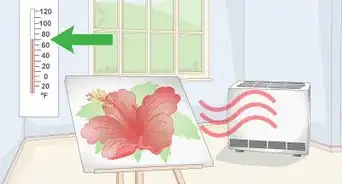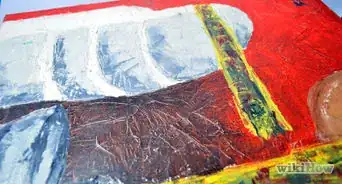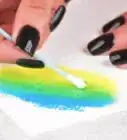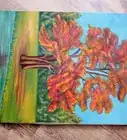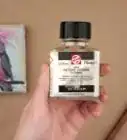This article was co-authored by Renée Plevy and by wikiHow staff writer, Eric McClure. Renée Plevy is an Internationally Acclaimed Portrait Artist from New York/Palm Beach who has painted The Grand Dames of Palm Beach and various celebrities and community leaders. With over 50 years of experience, Renée specializes in painting realistically in oil and capturing the soul of the person. She has studied under internationally renowned portrait artists John Howard Sanden, David Leffel, Robert Beverly Hale, Clyde Smith, and Leonid Gervits. Renée is featured in over 68 shows and galleries including a one-woman museum show at the Paterson Museum. She has garnered numerous awards including “Artist of the Year” from The Bloomfield Art League and First Prize from the Boca Raton Museum Artist’s Guild. Renée has even painted a portrait of celebrity, Vanilla Ice. She also teaches at the Boca Raton Museum Art School - formerly at SVA in Manhattan.
There are 14 references cited in this article, which can be found at the bottom of the page.
This article has been viewed 18,654 times.
While acrylic, watercolor, and tempera paints start drying in 20-30 minutes, oil paint won’t begin to dry for the first 24 hours that it’s sitting out. This makes it a great medium if you work on detailed paintings over a longer period of time or like to take frequent breaks while you work. However, sometimes you just don’t have enough time to finish a painting before the day is over. Don’t worry, though! There are plenty of ways to keep your paint wet for a little under a week. Keep in mind, paints that are stored for more than 5-6 days will begin to naturally cure on their own, regardless of the storage method you choose. Still, saving your paints for a few days beats wasting your hard-earned money on new paint! If you’re looking for a better way to organize your collection of paint, there are plenty of simple solutions as well.
Steps
Keeping Oil Paints from Drying Out
-
1Use a glass palette instead of a standard wood or plastic version. A wood palette will absorb oil paint and remove the moisture that keeps the pigment activated. This will dry your oil paint out quickly. A plastic palette is better than wood, but it is still more porous than glass and your paint won’t last as long. Stick with a glass palette when using oil paints to ensure that the moisture stays in your paint for as long as possible. They also have the added benefit of looking much cooler than regular palettes![1]
- If you sit down while painting, you can use a regular pane of glass instead of a palette. Be sure to put a towel underneath your palette or glass to ensure that you don’t scratch your table, though.
- Oil paint will dry on a glass palette in roughly 12 hours. On a plastic palette, it may last for 16-18 hours. A glass palette should keep your paint wet for at least 24 hours. These drying times depend on the temperature, light, and humidity in your workspace, though.
-
2Pack your paints into pieces of aluminum foil to store them individually. To store your colors individually, tear off a 6 in (15 cm) rectangle of aluminum foil for each color you’re storing. Use a palette knife to scoop your paint up and scrape the knife into the middle of the aluminum foil. Fold the foil around the glob of paint by wrapping the edges over the center of the foil. Do not apply pressure to the package of foil or flatten it out. Your oil paints will stay wet for 4-5 days in the aluminum foil.[2]
- To keep track of your colors, scrape a little bit of the paint on top of each package of aluminum foil.
- This is a great option if you work on multiple paintings at one time and want to store specific colors next to the painting they belong with. It’s also the best way to preserve that perfect shade you spent time mixing up since there’s no risk of your paint mixing with other colors nearby.
Advertisement -
3Mix clove oil into your paint to keep it wet for a longer period of time. Clove oil is an essential oil that comes from clove plants, and it’s often used for toothaches and aromatherapy. Use a palette knife or brush to mix 5-10 drops of clove oil into each color on your easel. The clove oil will keep your paint nice and soft while you aren’t using it, and your paint will stay wet if you leave it uncovered for 4-5 days.[3]
- Some artists are suspicious of clove oil and avoid using it because they think it changes the shades of their colors over time. If you don’t want the colors to change, clove oil may not be the best option for you.
- You can buy clove oil online or at your local pharmacy.
Variation: You can soak a sponge in clove oil and place it in an airtight case with your easel if you don’t want to mix anything directly into the paint. This will keep your paint wet for 3-5 days depending on how much air is in the container.[4]
-
4Cover your palette in plastic wrap and put it in the fridge for a faster option. If you don’t want to take the paints off of the palette, grab a roll of plastic food wrap. Pull out a length of plastic and wrap it tightly over your paint. Use additional lengths as needed to cover any gaps and keep air out. Then, put your palette in the refrigerator. Your paint will stay wet in the fridge for 3-5 days.[5]
- When you take your paint out of the refrigerator to get back to work, let the palette sit out for 30-45 minutes to give the paints time to reach room temperature. Cold paint can be harder to work with than room-temperature paint.
-
5Store large batches of paint in empty paint storage tubes. Purchase empty paint tubes designed for storing oil paint online or from an art supply store. Unscrew the large cap on the bottom of the tube and use your palette knife to scoop the oil paint up. Scrape the knife against the interior rim of the paint tube and close the cap. Your paint will stay wet for 4-5 days, although it may last longer if you squeeze the paint towards the front of the cap to remove air before closing the container.[6]
- To use your paint, take the smaller cap on the front of the tube off and squeeze the paint out of the tube like it’s a normal tube of paint.
- These tubes are typically pretty large and you can store several ounces of paint in them.
- For an easier alternative, you can scoop the paint into any airtight glass or metal container. The paint will stay wet for 2-3 days in one of these containers[7]
-
6Put a second glass palette on top of the palette you’re using to save your paint. If you are using a glass palette, get a second glass palette of an identical size. To store your paint and keep it wet, set your second palette on top of the first one. You can hold it directly over the top of the first one or simply cover a portion of the palette. Press it down gently into the paint to secure your paint and keep the majority of your color wet. While it depends how much paint you’re storing this way, your oil paint may last 3-4 days.[8]
- It doesn’t matter if the second palette is inverted on top of the first palette or simply resting at an asymmetrical angle. So long as the paint is squished between 2 panes of glass, it should stay wet.
- This is really only a good idea if you’re using a small amount of paint. Doing this with large globs of paint will spread it out too far on your palette.
- The edges of the paint that you store this way may have hardened by the time you want to paint, but the majority of the paint should stay wet.
Organizing Your Paint Tubes
-
1Store your paints in a warm, dark, and humid area. Cold temperatures, light, and dry air will cause oil paints to harden, which may impact your tubes of paint over time. To keep your paint tubes in tip-top shape, turn the lights off when you aren’t in the room. Keep the temperature in the room over 65 °F (18 °C), and don’t store your paints in a dry part of your home or studio.[9]
- If a lack of humidity is a big problem in your home or workspace, get a humidifier and leave it on when you work.
- Be careful not to keep your paints anywhere with extreme heat since it could cause them to separate.[10]
-
2Get a paint rack to easily store paint at your work station. A paint rack is basically a wood shelf with thin racks that hold paint tubes. Get a paint rack and lean it against the wall in your studio. Fill the shelves with your paint tubes by leaning them vertically against the back of the rack on each shelf. The lip at the front of each shelf will keep the bottom of the tube from sliding off and hold your paint in place. Purchase a paint rack online or at an art supply store.[11]
- Paint racks look pretty neat when the shelves are covered in rows of paint tubes. It’s probably the most aesthetically-pleasing way to store your paint.
Tip: A paint rack is the easiest way to functionally store your paint. It’s easy to see which color is in each tube since they aren’t hidden, and you can easily grab a tube whenever you need it.
-
3Stuff your oil paints in a drawer if you always paint at a desk. If you usually sit down when you paint, the easiest way to organize your paints is to lay them flat in one of your desk’s drawers. Leave each tube flat against the bottom of the drawer and stack similar colors on top of one another. This will keep your paint safe and make it easy to remember where your colors are without leaving the tubes out for everyone to see.
- Put a towel under the tubes at the bottom of the drawer to keep the paint from getting all over the interior off your desk.
-
4Use stackable boxes or a storage cabinet to keep supplies in one place. If you want to store tubes of paint alongside other art supplies, use a storage cabinet. Label each drawer or shelf and keep your brushes, knives, paints, and varnishes on separate shelves. Alternatively, you can use stackable boxes and label the side of each box. This will keep your paints from ending up all over the place and make it easier for you to find what you need.[12]
- You can also use stackable boxes to sort large quantities of paint by brand or color. You can put different brands of paint in different boxes, or separate them by color and sort your paint that way.
-
5Stick with a limited number of colors to minimize the paint you need. You can make basically any color using a combination of red, yellow, blue, black, and white. Stick with these colors and avoid buying pre-mixed shades of paint to minimize the number of paint tubes you need. This will keep you from digging around for specific shades in between painting sessions. It will also keep your palette from becoming overly-crowded by dozens of different shades.[13]
- This will also help you develop your mixing skills! With a limited number of colors, you’ll be forced to find a way to make those crazy shades and unique color combinations. You’ll learn a lot about color theory and paint mixing if you stick with primaries, white, and black.
-
6Keep paint tubes in a portable case to take paints on the go. There are portable cases that you can buy for paint tubes that look kind of like briefcases. They have tube-shaped slots surrounded by protective foam or plastic. This is a great option if you paint in multiple locations and need a mess-free way to transport your paint.[14]
Expert Q&A
-
QuestionWhat is the best way to store oil paint tubes?
 Renée PlevyRenée Plevy is an Internationally Acclaimed Portrait Artist from New York/Palm Beach who has painted The Grand Dames of Palm Beach and various celebrities and community leaders. With over 50 years of experience, Renée specializes in painting realistically in oil and capturing the soul of the person. She has studied under internationally renowned portrait artists John Howard Sanden, David Leffel, Robert Beverly Hale, Clyde Smith, and Leonid Gervits. Renée is featured in over 68 shows and galleries including a one-woman museum show at the Paterson Museum. She has garnered numerous awards including “Artist of the Year” from The Bloomfield Art League and First Prize from the Boca Raton Museum Artist’s Guild. Renée has even painted a portrait of celebrity, Vanilla Ice. She also teaches at the Boca Raton Museum Art School - formerly at SVA in Manhattan.
Renée PlevyRenée Plevy is an Internationally Acclaimed Portrait Artist from New York/Palm Beach who has painted The Grand Dames of Palm Beach and various celebrities and community leaders. With over 50 years of experience, Renée specializes in painting realistically in oil and capturing the soul of the person. She has studied under internationally renowned portrait artists John Howard Sanden, David Leffel, Robert Beverly Hale, Clyde Smith, and Leonid Gervits. Renée is featured in over 68 shows and galleries including a one-woman museum show at the Paterson Museum. She has garnered numerous awards including “Artist of the Year” from The Bloomfield Art League and First Prize from the Boca Raton Museum Artist’s Guild. Renée has even painted a portrait of celebrity, Vanilla Ice. She also teaches at the Boca Raton Museum Art School - formerly at SVA in Manhattan.
Portrait Artist & Educator Make sure you clean off the screw caps and threading on the tubes so they're easier to take off.
Make sure you clean off the screw caps and threading on the tubes so they're easier to take off.
Things You’ll Need
Keeping Oil Paints from Drying Out
- Aluminum foil
- Clove oil
- Plastic wrap
- Palette knife
- Brush
- Storage tubes
- Glass palette
Organizing Your Paint Tubes
- Paint rack
- Desk
- Cabinet
- Stackable boxes
- Portable case
References
- ↑ https://youtu.be/JemraWZ5Idk?t=30
- ↑ https://youtu.be/qJHnf1PgBVM?t=43
- ↑ https://youtu.be/qJHnf1PgBVM?t=83
- ↑ https://youtu.be/qJHnf1PgBVM?t=134
- ↑ https://youtu.be/qJHnf1PgBVM?t=145
- ↑ https://youtu.be/qJHnf1PgBVM?t=177
- ↑ https://youtu.be/JemraWZ5Idk?t=54
- ↑ https://youtu.be/JemraWZ5Idk?t=107
- ↑ https://thetahoeweekly.com/2017/04/watching-paint-dry-different-climates-affect-painting/
- ↑ Renée Plevy. Portrait Artist & Educator. Expert Interview. 7 May 2021.
- ↑ https://youtu.be/VVEI30w50k4?t=176
- ↑ https://theartofeducation.edu/2017/07/12/tricks-keeping-paint-organized/
- ↑ https://theartofeducation.edu/2017/07/12/tricks-keeping-paint-organized/
- ↑ https://www.apartmenttherapy.com/organizing-ideas-how-to-keep-diy-supplies-organized-247798
- ↑ https://thetahoeweekly.com/2017/04/watching-paint-dry-different-climates-affect-painting/
- ↑ https://youtu.be/qVGgKs0ZflQ?t=191
